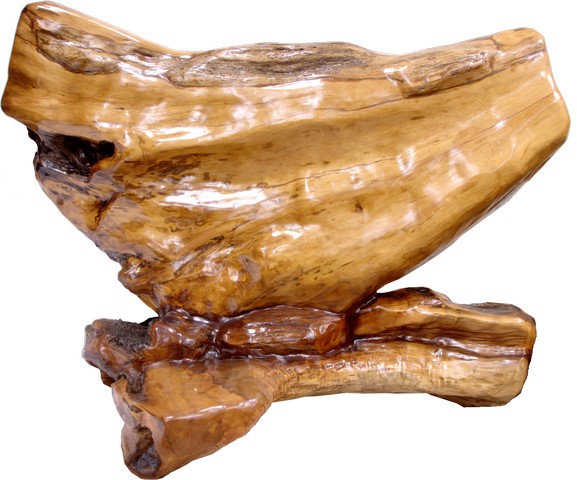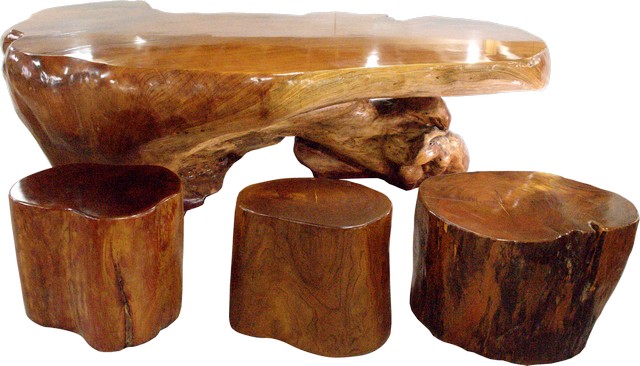To Know Precious Woods
.jpg)
1. Taiwan Cypress
Taiwan Cypress is one of the evergreen trees and is in the cypress family Cupressaceae. It is endemic and grows at altitudes of 1500–2500 meters. There are seven species of cypress in the world and they are native to Taiwan, Japan, U.S.A. and east coast of the Pacific.
However, there are only two species in the cypress family are native in Taiwan. One is Taiwan Red Cypress and the other one is Taiwan Cypress. Taiwan Red Cypress is the largest coniferous tree in East Asia and it grows to 60 m tall with average height of 30~40 m.
The trunk is up to 6 m in diameter while it needs about 120~130 years to grow 50 cm in diameter and uses up about 90 years to grow one cubic meter in volume. As for the first grade coniferous tree of Taiwan Cypress, its height is similar to Taiwan Red Cypress. The trunk is straight and even. It grows far slowly than Taiwan Red Cypress. For growing to 50 cm tree in diameter will take 350~400 years and using up about 320 years to grow one cubic meter in volume.
Taiwan Red Cypress commonly known as “thin bark” while Taiwan Cypress (Yellow Cedar) as “thick bark” and are collectively called as cypress. The cypress trees contain a lot essential oil (so-called phytoncide) which is with fragrance but no pungent smells. The wood of cypress is hard, highly decay-resistant and not easily be moth-eaten. Those characteristics make the wood of cypress becomes the supreme materials for construction, sculpture, furniture and decoration.
Phytoncides are called botanical essence derived from the leaves, stems and flowers of plants. This self-defense aroma is antimicrobial and the major element is one unsaturated carbohydrates (Delete). The cypress essential oil is the best essential oil for people to sterilize things, relax and calm themselves since ancient times.
The advantage of cypress, Taiwan incense-cedar and stout camphor essential oils is completely natural. It won’t do any harm to human body cells and beneficial bacteria but may eliminate bad bacteria and diminish inflammation. Not to mention it could stabilize nerves, improve healthy and increase immunity to diseases without any side effect.

2. Taiwan Incense-Cedar
Taiwan Incense-Cedar (commonly known as “yellow meat”) is also in the cypress family Cupressaceae and is one endemic evergreen tree. It grows in mountain areas at altitudes of 3000–500 meters. The tree’s shape is long conical. The bark is red-brown and the pale red resin will outflow after cutting on it.
Giant Incense-Cedar in Taiwan is about the same as cypress trees. The tree appearance is beautiful and also be planted as landscape trees. Taiwan Incense-Cedar is one hermaphrodite plant. The cone is lignified and in the shape of long ovoid. The seed has two fin-shaped structures. The leaves are scale-like, small but slender than the leaves of Taiwan Cypress.
The wood is with dense fine texture and is less susceptible to termites and pests. The wood color is like tan and is widely used in construction, furniture, sculpture and decoration. To grind the wood down to powder which could be used as aromatizer and some people treat them as “Taiwan Sandalwood”.
Even there’s a buying offer for scraps since the fragrance is so charming. The essential oil of Taiwan Incense-Cedar is rare and expensive. The wood is fine and usually used for exquisite carvings. It is one rare coniferous giant tree in low altitude areas.
Taiwan Incense-Cedar, Taiwan Cypress, Taiwan Red Cypress, Luanta-Fir and Taiwania are regarded as “Taiwan Five Coniferous Tress” since they are rare and precious.
.jpg)
3. Taiwan Stout Camphor Tree
Stout Camphor Trees distribute at low altitudes of 200–2000 m foliage forests in mountains of Taiwan. Due to past over-exploitation lead to only few old trees left in high mountains, so conservation should be strictly enforced.
Because of its special strong fragrance and also for the sake of its rare expensive essential oil, people believe it will eliminate bacteria, diminish inflammation, inhibit tumor cells, stabilize nerves, calm the emotion and help sleep. The wood is dark brown and usually used in construction, furniture and carving artworks. Especially when the said tree withered and fell down, there are special parasitic fungus will grow on the inner rotten heartwood wall.
Thefruiting body of Antrodia Camphorata is known as the precious medicine “Niu-Chang Chih”. People believe “Niu-Chang Chih” works for anti-allergy, resolve stasis, solve toxin, diminish inflammation, anti-virus and anti-cancer. The marketing price is amazingly high. Even more, this tree has become the species usually poached by “mountain rat”. It’s very difficult to cultivate Taiwan Stout Camphor trees and more likely these trees will vanish slowly in Taiwan.
Thus, the government regulated this tree as first grade wood for conservation and forbid to cutting and trading of it.
Taiwan Luanta-Fir
Taiwan Luanta-Fir is known as Cunninghamia Konishii which is scattered in the cypress forest and is one of the southeast relic types. The tree bears strip flaked, needle-like leaves that spiral around the stem with an upward lanceolate shape. The leaves are slightly bending like the shape of mowing sickle.
One Taxodiaceae family feature is the cone seed scales and bract scales are symbiotic. The Luanta-Fir which is native in Taiwan is different in the shape of leaves from the ones are native in China. The leaves of Taiwan Luanta-Fir are smaller and bear the similar phytoncide fragrance like Taiwan Cypress (Yellow Cedar).
The wood is fine, hard like Yellow Cedar and is widely used for construction, sculpture, furniture and decoration.
5. Taiwan Yew
The tree is rare and located in middle-high altitude mountains at Taiwan. The wood is one expensive carving material. From the bark and coniferous leaves could be extracted paclitaxel which possess the effect of anti-cancer and thus make it multiply in values.
The fresh sapwood is in yellow earth tones and the vertical lines are not obvious. The wood is flexible, temperature-resistant and bears extraordinary beautiful patterns. However, there is a very significant difference on cambium. The sapwood is yellow-white while the heartwood is dark reddish-brown. The tree-rings are clear, uneven and narrow. There is no distinctive difference between spring timber and autumn timber. Autumn timber is narrow without resin channels and cells.
The wood lines are very fine and could be seen the wood pattern slants with delicate texture through the magnifier. The wood is flexible, less cracked and non-tilting. The wood can be preserved long and temperature-resistant. Be the first grade coniferous tree and as the national treasure species, it’s ban to logging.
This tree is rare in the world as well so the artwork make from it worth collecting very much.

6. Taiwan Zelkova
Zelkova is commonly known as “chicken oil” tree. To plane the wood will get waxy oil touch and is like coated with chicken oil which makes it a very high ranking wood. The tree shape is just like one big broom. The branches and leaves are very gently beautiful, too.
The edges of leaves are thin serrated and make those small leaves looks even more adorable. Zelkova is like Formosan Ash, its bark is with luster. After the bark peeling off will leave the trunk mottled marks like clouds. The timber of Taiwan Zelkova could be colors red or yellow. The texture is fine, hard and heavy. The wood patterns are varied and partially with glittering sparklers. They are the high ranking timber could be compared to foreign rosewood, which are the noble materials used in construction, sculpture, furniture and decoration.
7. “Tree Essential Oil” means “Wood Phytoncide”
(Including Taiwan Red Cypress, Taiwan Yellow Cedar, Taiwan Incense-Cedar, Stout Camphor Tree and Camphor Tree)
The tree essential oil products are extracted individually from the rare plants of Taiwan Red Cypress, Taiwan Yellow Cedar, Taiwan Incense-Cedar, Stout Camphor and Camphor, wherein contains more than hundreds of natural ingredients and there’s no chemical compound can replace it in a short period of time. As a result of high cost to extract pure plants’ essential oils, it’s quite difficult to purchase pure tree essential oils in the market. Tree essential oils are mostly extracted by plant distillation and the oils contain very high volume of herbal distillate. Generally, it will take over one pound of plants at least to extract one drop of essential oil. For producing one kilogram tree essential oils from Stout Camphor or Cypress tress will need around 500 kilograms of materials. Most manufacturers are not willing to extract this kind of oils due to the high costs. Some manufacturers will offer non-100% pure tree essential oils by diluting other species of plant oils. So it's recommended to buy the oils carefully from the direct-raw-material manufacturer who bears good credit.
Research on the spreaded effects of tree essential oils:
1. Skin: Tree essential oil is one of the anti-aging medium which may stimulate skin cells, accelerate the regeneration, shorten the metabolism time of old cells, slow down the aging process, help on scar repair, improve wound healing and increase skin immunity to outer attacks. So the skin will appear to be energetic and healthy as long as through the treatment of tree essential oils.
2. Pharmacology: Tree essential oils mostly have the effects of purify air, anti-bacteria, sterilize, anti-virus and sedation. Some essential oils may relieve acute discomforts, like diminish inflammation, stop pain, handling of early urinary tract infection and early symptoms of flu. On the other hand, essential oils also have effects on long term symptoms, such as chronic bronchitis, arthritis, hormone adjustments and to improve irregular gynecological menstrual.
3. Health: The aromatic molecules in the tree essential oils may reinforce, stimulate body immunity, activate human body’s original nature ability, promote metabolism, improve body circulation, get rid of excess water and toxins in the body, enliven the problem organs, maintain and enhance the body resistance with internal body balance.
4. Emotion: Tree essential oils may enhance one’s memory, improve emotion, increase confidence, clear up pressure or remove physical fatigue and lots of negative energy. Modern people are often faced stress from work and family and the stress may lead to one’s emotional disorder. Tree essential oils are with great effects on balancing thoughts, calming emotion and helping sleep.
5. Spirit: Tree essential oils may be through visual, touch and smell to stimulate cerebral cortex, inspire thoughts, offer spiritual comforts, release varieties of psychological and spiritual burdens. Besides, the essential oils may enhance the spiritual realm, help people towards positive life attitude, increase personal communication and create better relationships with people.

 5003 Purple Rosewood Table – Extra Large 2.5*1.8*.7*2T.
5003 Purple Rosewood Table – Extra Large 2.5*1.8*.7*2T.
5003 Purple Rosewood Table – Extra Large 2.5*1.8*.7*2T.
5003 Purple Rosewood Table – Extra Large 2.5*1.8*.7*2T.
 5005 Red Zelkova Table 1.9*1*0.7*1T.
5005 Red Zelkova Table 1.9*1*0.7*1T.
5005 Red Zelkova Table 1.9*1*0.7*1T.
5005 Red Zelkova Table 1.9*1*0.7*1T.
 5012 Redwood Burl Screen – Extra Large 1.5*.7*2*300
5012 Redwood Burl Screen – Extra Large 1.5*.7*2*300
5012 Redwood Burl Screen – Extra Large 1.5*.7*2*300
5012 Redwood Burl Screen – Extra Large 1.5*.7*2*300
 5014 Taiwan Incense-Cedar Root Burl Screen - Ingot 1.5*1*1.5*500
5014 Taiwan Incense-Cedar Root Burl Screen - Ingot 1.5*1*1.5*500
5014 Taiwan Incense-Cedar Root Burl Screen - Ingot 1.5*1*1.5*500
5014 Taiwan Incense-Cedar Root Burl Screen - Ingot 1.5*1*1.5*500
 5018 Stout Camphor Root – Alligator 2.1*.6*.8*65
5018 Stout Camphor Root – Alligator 2.1*.6*.8*65
5018 Stout Camphor Root – Alligator 2.1*.6*.8*65
5018 Stout Camphor Root – Alligator 2.1*.6*.8*65
 5037 Boxwood Carving Long-Life Elder 0.2*1.5*.6*15
5037 Boxwood Carving Long-Life Elder 0.2*1.5*.6*15
5037 Boxwood Carving Long-Life Elder 0.2*1.5*.6*15
5037 Boxwood Carving Long-Life Elder 0.2*1.5*.6*15
 5047 Yellow Cedar Long Recliner 2.2*.8*.9*500
5047 Yellow Cedar Long Recliner 2.2*.8*.9*500
5047 Yellow Cedar Long Recliner 2.2*.8*.9*500
5047 Yellow Cedar Long Recliner 2.2*.8*.9*500
http://www.taiwantreasure.com.tw/index.php?option=com_content&view=article&id=104&Itemid=565&lang=en#sigProIdd4873db962


